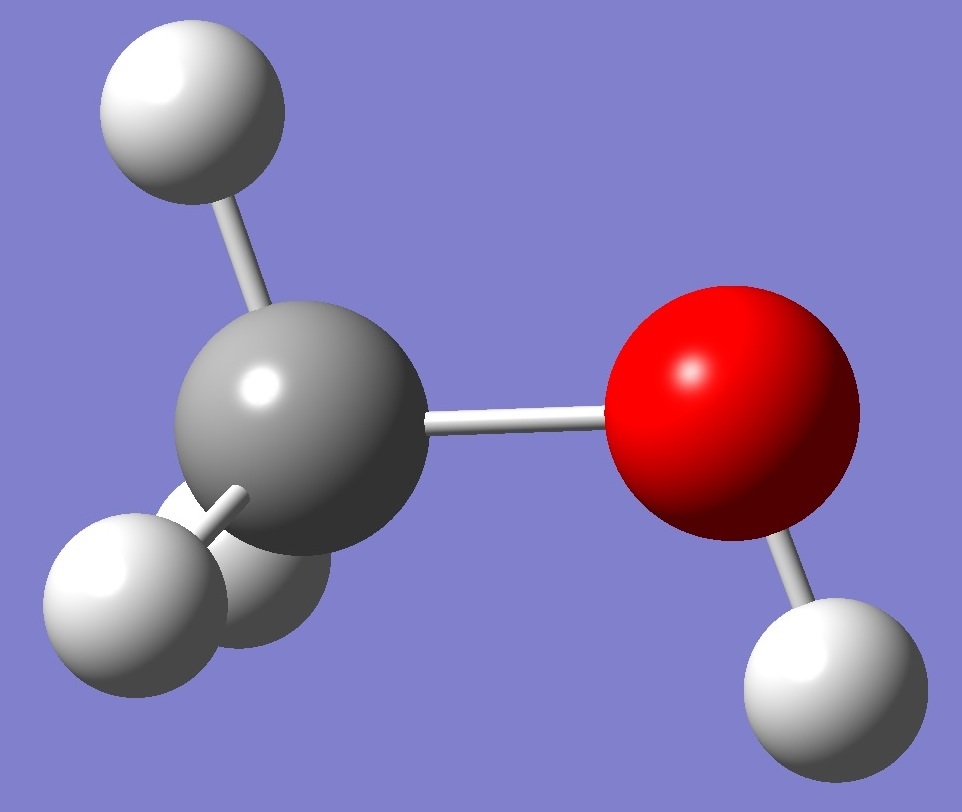|
|
|
|
|
|
|
|
|
|
|
|
|
|
|
|
|
|
|
|
|
CH3OD |
|
|

|
|
|
|
|
|
|
|
|
|
|
|
|
|
|
|
|
|
|
|
|
|
|
|
|
|
|
|
|
|
|
|
|
|
|
Deuterium |
|
|
|
Nuclear
Quadrupole Coupling Constants |
|
|
|
in
Methanol |
|
|
|
|
|
|
|
|
|
|
|
|
|
|
|
|
|
|
|
|
|
|
|
|
|
|
|
|
|
|
|
|
|
Deuterium nqcc's were measured in CH3OD
by Casleton and Kukolich [1]. |
|
|
|
|
|
|
|
|
|
|
|
|
Calculation of the deuterium nqcc
tensor
was made on an ropt structure given by MP2/aug-cc-pVTZ(G03)
optimization. These nqcc's are compared with the experimental
values in Table 1. Structure parameters
are given
in Table 2. |
|
|
|
|
|
|
|
|
|
|
|
|
In Table 1, subscripts a,b,c
refer to the principal axes of the inertia tensor, subscripts x,y,z to
the principal axes of the nqcc tensor. The nqcc y-axis is chosen
coincident with the inertia c-axis, these are perpendicular to the
plane of the molecule. Ø (degrees) is the angle between
its subscripted parameters. ETA = (Xxx - Xyy)/Xzz. |
|
|
RMS is the root
mean square difference between calculated and experimental diagonal
nqcc's
(percentage of the average of the magnitudes of the experimental
nqcc's).
RSD is the calibration residual standard deviation for the model for
calculation of the nqcc's. |
|
|
|
|
|
|
|
|
|
|
|
|
|
|
|
|
|
|
|
|
|
|
| |
|
|
|
|
|
|
|
|
Table 1. Deuterium nqcc's
in CH3OD (kHz). Calculation was made
on the ropt structure. |
|
| |
|
|
|
|
|
|
|
|
|
|
|
Calc. |
|
Expt. [1] |
|
| |
|
|
|
|
|
|
|
|
2H |
Xaa |
|
- 52.4 |
|
|
|
|
|
Xbb |
|
220.8 |
|
|
|
|
|
Xcc |
- |
168.4 |
|
|
|
|
|
|Xab| |
|
158.3 |
|
|
|
|
|
|
|
|
|
|
|
|
|
RMS |
|
|
|
|
|
|
|
RSD |
|
1.1 (0.9 %) |
|
|
|
|
|
|
|
|
|
|
|
|
|
Xxx |
- |
124.8 |
|
|
|
|
|
Xyy |
- |
168.4 |
|
|
|
|
|
Xzz |
|
293.3 |
|
303(12) *
|
|
|
|
ETA |
|
0.148 |
|
|
|
|
|
Øz,a |
|
65.40 |
|
|
|
|
|
Øa,OD |
|
66.06 |
|
|
|
|
|
Øz,OD |
|
0.66 |
|
|
|
|
|
|
|
|
|
|
|
|
|
|
|
|
|
|
|
|
|
|
|
|
* Bond axis coupling constant.
|
|
|
|
|
|
|
|
|
|
|
|
|
|
|
|
|
| Table 2. CH3OH
Molecular structure parameters, ropt (Å and
degrees). |
| |
|
|
|
 |
|
CHs |
1.0860 |
|
CHa |
1.0912 |
|
CO |
1.4243 |
|
OH |
0.9612 |
|
HsCO |
106.54 |
|
HaCO |
111.83 |
|
COH |
107.98 |
|
HsCHa |
108.65 |
|
HaCHa |
109.21 |
|
|
|
|
|
|
|
|
|
|
|
|
|
|
|
|
|
|
|
|
|
|
|
[1] K.H.Casleton and
S.G.Kukolich, Chem.Phys.Lett. 22,331(1973). |
|
|
|
|
|
|
|
|
|
|
|
|
|
|
|
|
|
|
|
|
|
|
Benzoic Acid |
HC(=O)OD |
HOCl |
CF3COOH |
|
|
|
|
|
|
|
|
|
|
|
|
|
|
|
|
|
|
|
|
|
|
Table of Contents |
|
|
|
|
|
Molecules/Deuterium |
|
|
|
|
|
|
|
|
|
|
|
|
|
|
|
|
|
|
|
|
|
|
|
|
|
|
|
|
|
|
CH3OD.html |
|
|
|
|
|
|
Last
Modified 24 June 2010 |
|
|
|
|
|
|
|
|
|
|

